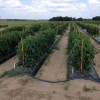Abstract
Durante la última década, las frutas, verduras y frutos secos se encuentran entre los alimentos relacionados con brotes de gastroenteritis causadas por cepas enterovirulentas de E. coli y Salmonella no tifoidea que resultan en miles de hospitalizaciones y pérdidas de varios millones de dólares en la industria de alimentos (Mandrell 2009; Batz, Hoffman, y Morris 2011). Desde 2006, dieciséis brotes de salmonelosis se han relacionado con el consumo de frutas y verduras, incluyendo tomates, melones, coles, pepinos, mangos, piñones, pistachos, mantequilla de maní, papayas, pimientos y además alimentos congelados y procesados que contienen productos vegetales. Esta hoja informativa fue producida para proveer información actualizada sobre las prácticas de producción de tomate y sus asociaciones con Salmonella. Esta información es útil para Agentes de Extensión Agraria en sus programas de educación sobre cultivos hortícolas.
This 4-page fact sheet is the Spanish-language version of SL415/SS628: The Role of Crop Production Practices and Weather Conditions in Microbiological Safety of Tomatoes and Peppers. It was written by Massimiliano Marvasi, Max Teplitski, and George Hochmuth, and published by the UF Department of Soil and Water Science, February 2015.
References
Brandl, M. T., C. E. Cox, y M. Teplitski. 2013. "Salmonella interactions with plants and their associated microbiota." Phytopathology 103: 316-325. https://doi.org/10.1094/PHYTO-11-12-0295-RVW
Greene, S. K., E. R. Daly, E. A. Talbot, L. J. Demma, S. Holzbauer, et al. 2008. "Recurrent multistate outbreak of Salmonella Newport associated with tomatoes from contaminated fields, 2005." Epidemiol Infect 136: 157-165. https://doi.org/10.1017/S095026880700859X
Gutierrez-Rodriguez, E., A. Gundersen, A. O. Sbodio, y T. V. Suslow. 2012. "Variable agronomic practices, cultivar, strain source and initial contamination dose differentially affect survival of Escherichia coli on spinach." J Appl Microbiol 112: 109-118. https://doi.org/10.1111/j.1365-2672.2011.05184.x
Iniguez, A. L., Y. M. Dong, H. D. Carter, B. M. M. Ahmer, J. M. Stone, et al. 2005. "Regulation of enteric endophytic bacterial colonization by plant defenses." Molecular Plant-Microbe Interactions 18: 169-178. https://doi.org/10.1094/MPMI-18-0169
Islam, M., J. Morgan, M. P. Doyle, S. C. Phatak, P. Millner, et al. 2004a. "Persistence of Salmonella enterica serovar Typhimurium on lettuce and parsley and in soils on which they were grown in fields treated with contaminated manure composts or irrigation water." Foodborne Pathog Dis 1: 27-35. https://doi.org/10.1089/153531404772914437
Islam, M., J. Morgan, M. P. Doyle, S. C. Phatak, P. Millner P, et al. 2004b. "Fate of Salmonella enterica serovar Typhimurium on carrots and radishes grown in fields treated with contaminated manure composts or irrigation water." Appl Environ Microbiol 70: 2497-2502. https://doi.org/10.1128/AEM.70.4.2497-2502.2004
Larbat, R., J. Le Bot, F. Bourgaud, C. Robin, y S. Adamowicz. 2012. "Organ-specific responses of tomato growth and phenolic metabolism to nitrate limitation." Plant Biol (Stuttg). https://doi.org/10.1111/j.1438-8677.2012.00564.x
Lopez-Velasco, G., A. Sbodio, A. Tomas-Callejas, P. Wei, K. H. Tan, et al. 2012. "Assessment of root uptake and systemic vine-transport of Salmonella enterica sv. Typhimurium by melon (Cucumis melo) during field production." Int J Food Microbiol 158: 65-72. https://doi.org/10.1016/j.ijfoodmicro.2012.07.005
Mandrell, R. 2009. "Enteric human pathogens associated with fresh produce: sources, transport, and ecology." In Microbial Safety of Fresh Produce, edited by X. Fan, B. A. Niemira, C. J. Doona, F. E. Feeherry, and R. B. Gravani. Ames, Iowa: Blackwell Publishing and the Institute of Food Technologies.
Marvasi, M., A. S. George, M. Giurcanu, G. J. Hochmuth, J. T. Noel, et al. 2014. "Effects of nitrogen and potassium fertilization on the susceptibility of tomatoes to post-harvest proliferation of Salmonella enterica." Food Microbiol 43: 20-27. https://doi.org/10.1016/j.fm.2014.03.017
Marvasi, M., G. J. Hochmuth, M. C. Giurcanu, A. S. George, J. T. Noel, et al. 2013. "Factors that affect proliferation of Salmonella in tomatoes post-harvest: the roles of seasonal effects, irrigation regime, crop and pathogen genotype." PLoS One 8: e80871. https://doi.org/10.1371/journal.pone.0080871
Moyne, A. L., M. R. Sudarshana, T. Blessington, S. T. Koike, M. D. Cahn, et al. 2011. "Fate of Escherichia coli O157:H7 in field-inoculated lettuce." Food Microbiology 28: 1417-1425. https://doi.org/10.1016/j.fm.2011.02.001
Poza-Carrion, C., T. V. Suslow, y S. E. Lindow. 2013. "Resident bacteria on leaves enhance survival of immigrant cells of Salmonella enterica." Phytopathology 103. https://doi.org/10.1094/PHYTO-09-12-0221-FI
Roy, D., S. Panchal, B. A. Rosa, y M. Melotto. 2013. "Escherichia coli O157:H7 induces stronger plant immunity than Salmonella enterica Typhimurium SL1344." Phytopathology 103.
https://doi.org/10.1094/PHYTO-09-12-0230-FI
Snoeijers, S. S., A. Perez-Garcia, M. H. A. J. Joosten, y P. J. G. M. De Wit. 2000. "The effect of nitrogen on disease development and gene expression in bacterial and fungal plant pathogens." European Journal of Plant Pathology 106: 493-506. https://doi.org/10.1023/A:1008720704105
Thompson, S., S. Levin, y I. Rodriguez-Iturbe. 2013. "Linking plant disease risk and precipitation drivers: a dynamical systems framework." Am Nat 181: E1-16. https://doi.org/10.1086/668572
Williams, T. R., A. L. Moyne, L. J. Harris, y M. L. Marco. 2013. "Season, irrigation, leaf age, and Escherichia coli inoculation influence the bacterial diversity in the lettuce phyllosphere." Plos One 8: e68642. https://doi.org/10.1371/journal.pone.006864

